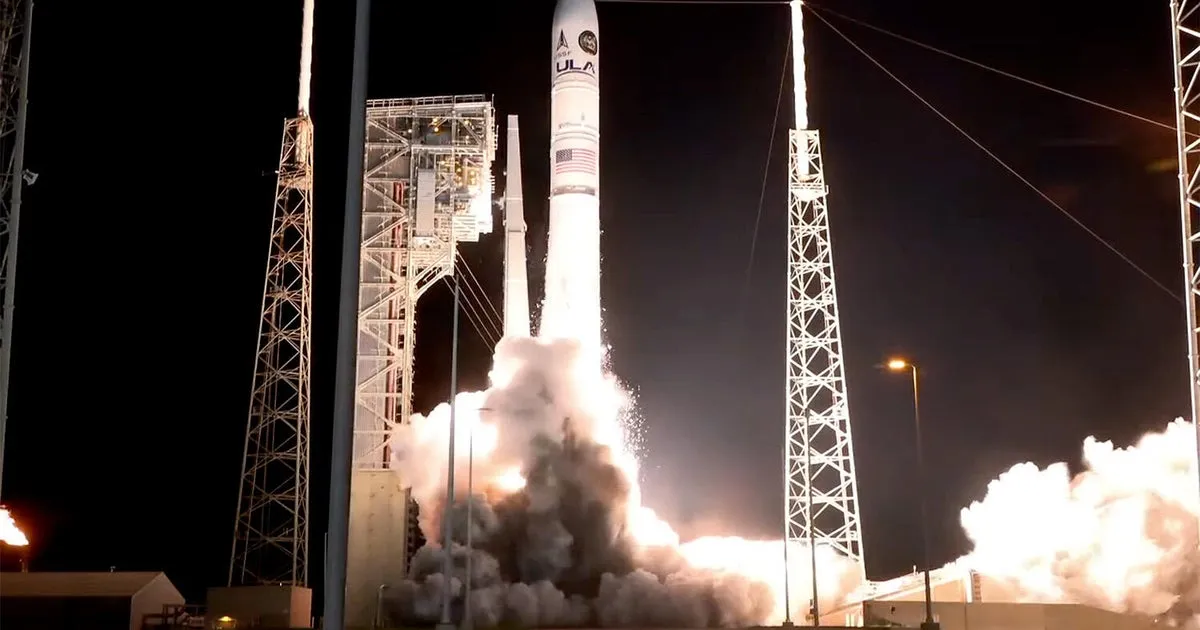
United Launch Alliance (ULA) achieved a significant milestone on Tuesday with the successful launch of its first operational Vulcan rocket. This mission, which boosted two military satellites into space, marked the inaugural flight sanctioned by the U.S. Space Force for this new launcher, designed to eventually replace ULA's legacy Atlas 5 and retired Delta rockets.
The Vulcan rocket, towering at 198 feet, is equipped with four solid-fuel strap-on boosters that provide additional power during takeoff. The rocket's two methane-fueled BE-4 engines roared to life at 8:56 p.m. EDT, propelling the vehicle away from pad 41 at the Cape Canaveral Space Force Station. As it ascended into the night sky, the Vulcan created a stunning display, generating nearly 3 million pounds of thrust and a brilliant exhaust plume visible for miles.
Shortly after liftoff, the four strap-on boosters were jettisoned, followed by the burnout and separation of the Vulcan's 109-foot-tall first stage approximately three and a half minutes into the flight. The mission continued with the ignition of the Centaur second stage, powered by two hydrogen-fueled Aerojet Rocketdyne RL10C engines. However, in accordance with military protocols, ULA ceased its live commentary at this point, and further details of the flight remained classified.
At least two satellites were carried aboard the Vulcan: one highly classified spacecraft and an experimental satellite designed to test upgraded atomic clocks and navigation technology. This technology could enhance the accuracy of Global Positioning System (GPS) data for both military and commercial applications. Both satellites are destined for a geosynchronous orbit at 22,300 miles above the equator, where they will appear stationary in the sky as they complete one orbit every 24 hours.
The experimental satellite, known as Navigation Technology Satellite 3 (NTS-3), will operate from this higher orbit and features an advanced phased array antenna capable of electronically directing signals to multiple receivers across wide areas. This represents the Pentagon's first experimental navigation satellite since the launch of GPS precursors in the 1970s. The NTS-3 program, designed and built by L3Harris Technologies, includes a ground-based control system and receivers that can be rapidly reprogrammed for upgrades and signal utilization.
"GPS is an integral part of our lives today," said Joanna Hinks, a senior aerospace engineer with the Air Force Research Laboratory. "With NTS-3, we will be experimenting with various technologies to evolve and enhance GPS, ensuring it remains the gold standard for our warfighters." This mission not only emphasizes the importance of the satellites launched but also highlights the advancements in military navigation technology.
The launch was a pivotal moment for ULA, marking the third flight of the Vulcan after two test launches in the previous year. It was the first mission certified by the Space Force for carrying high-value national security payloads, which include spy satellites and other military spacecraft. Gary Wentz, ULA's vice president of government and commercial programs, noted, "This mission is headed directly to geosynchronous orbit and will be one of our longest missions to date. The Vulcan was specifically designed to support these missions."
The Vulcan rocket is set to replace ULA's retired Delta family and the venerable Atlas 5, which has relied on Russian-built RD-180 engines. ULA's shift to an all-American launcher comes amid congressional pressure to eliminate reliance on foreign engines for U.S. military satellite launches. Currently, ULA has 13 Atlas 5 rockets left in its inventory, all earmarked for civilian launches, as the company transitions to its new Vulcan fleet.
As ULA moves forward with its Vulcan rocket, SpaceX continues to dominate the global launch market with its successful Falcon 9 and Falcon Heavy rockets. In 2023 alone, SpaceX has completed 97 launches. However, ULA President and CEO Tory Bruno emphasized the Vulcan's capabilities, particularly its performance-enhancing BE-4 engines and high-energy Centaur upper stage, making it ideal for launching heavy military payloads into challenging orbits.
Bruno explained that the Vulcan's design enables it to deliver the Centaur with a full load of propellant directly to geosynchronous orbit, enhancing mission capability while conserving satellite propellant. He noted, "One core is cheaper and more efficient than three expendable cores," underscoring the Vulcan's operational efficiency.
United Launch Alliance is expanding its ground infrastructure and anticipates launching nine flights in 2025, with plans to reach a cadence of two launches per month by the end of that year. The company is poised to conduct between 20 to 25 flights in 2026, further solidifying its position in the aerospace industry.